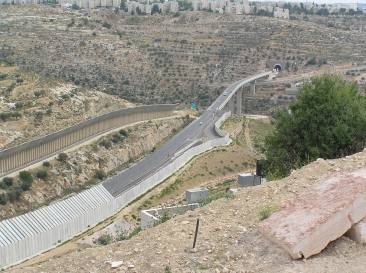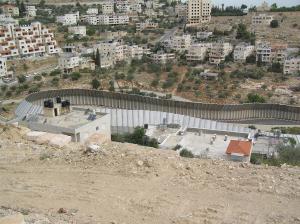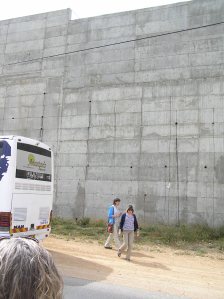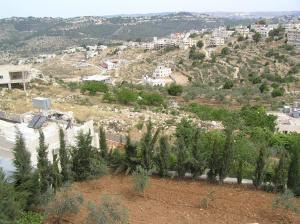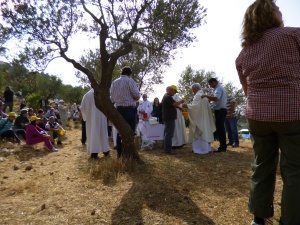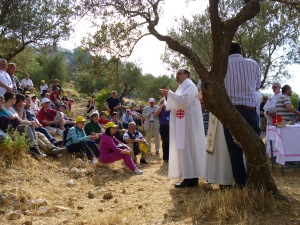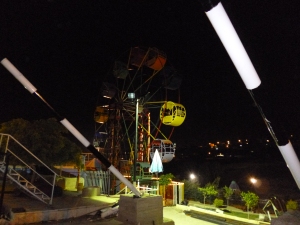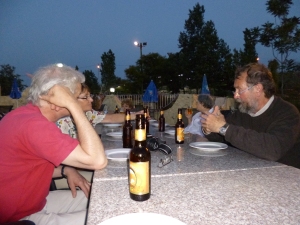This morning we were taken to the Palestinian village of Al Walaja. On the way we stopped at Beit Jalal to look down upon the road that has been built through the village.
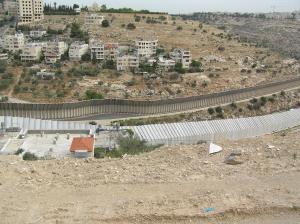
Road built through Beit Jalal. Not open to Palestinians although it passes through the middle of their land.
While we looked dpwn upon the road (Route 60) we heard one Muslim Palestinian tell us of his life. Growing up as a refugee his family lived in one room for 25 years. He grew up with mostly Christian neighbours but they never thought of themselves as Christian or Muslim but just as neighbours. He told us about how he had had to take his son to hospital in Jerusalem for an operation. It would have taken several hours to pass through the checkpoint so he applied for a permit to travel on the bus along the Israeli road. He was granted the permit, but when he was asked to get off the bus to have his permit checked, the Israeli guard told the bus to drive off without him. He had to return and wait to get through the checkpoint.
At Al Walaja we saw where the Jewish settlement has been built close to the Palestinian village, separated from it by the wall. Houses on the Palestinian side have been demolished, seemingly at random – one house will be demolished, leaving the one next door. Interestingly as the wall had not been completed here, we were able to see that the other side – the side facing the settlement has been nicely faced in stone to match the houses!
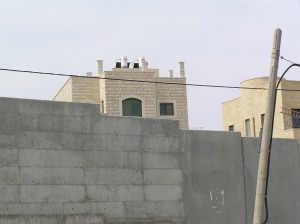
The Settlement houses peer over the wall, but Palestinian houses opposite have been demolished, leaving the families homeless.
From here we went further down into the village to see another house which had previously been demolished but had been rebuilt with help from the Amos Trust. Here we were welcomed by the family who invited all 25 of us into their home and gave us tea and coffee – in two shifts as there were not quite enough cups to go round!
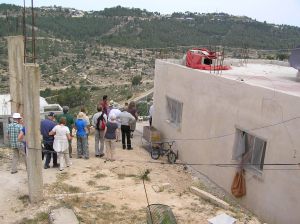 In 2000 this family’s home was finished after 5 years building. In 2004 a demolition order was placed on it and the house was demolished. The family went to live in a refugee camp for 7 years. The house has now been rebuilt but it received a new demolition order giving the family 72 hours to protest in the court. The Order was posted on Wednesday evening, which meant that since the courts close at midday Thursday and all of Friday and Saturday they had to go to court the following morning or wait until Sunday. By this time the 72 hours would have expired so the house could have been demolished on the Sunday morning. However, the family managed to find a lawyer to post their protest in time on the Thursday morning. The court case is ongoing.
In 2000 this family’s home was finished after 5 years building. In 2004 a demolition order was placed on it and the house was demolished. The family went to live in a refugee camp for 7 years. The house has now been rebuilt but it received a new demolition order giving the family 72 hours to protest in the court. The Order was posted on Wednesday evening, which meant that since the courts close at midday Thursday and all of Friday and Saturday they had to go to court the following morning or wait until Sunday. By this time the 72 hours would have expired so the house could have been demolished on the Sunday morning. However, the family managed to find a lawyer to post their protest in time on the Thursday morning. The court case is ongoing.
We then drove to another house that had been rebuilt with the help of Amos at Battir. This family had their house de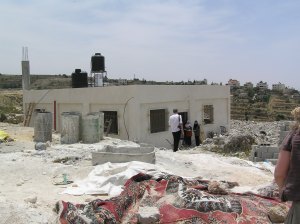 molished immediately after the 2nd intifada when an emergency order had been enacted by the Israeli military authorities. The family had no warning. The children were at school, father at work and mother visiting her mother in hospital. The house was bulldozed while they were out and so they have been living with the Father’s parents. They are thrilled that the house will soon be completed and they can return to their own home.
molished immediately after the 2nd intifada when an emergency order had been enacted by the Israeli military authorities. The family had no warning. The children were at school, father at work and mother visiting her mother in hospital. The house was bulldozed while they were out and so they have been living with the Father’s parents. They are thrilled that the house will soon be completed and they can return to their own home.
In between these two houses we met another family whose house is being completely annexed by the wall, leaving him to access the village through a tunnel. The village will be completely surrounded by the wall with a single check-point to get in and out. The gate has been placed to prevent the family using the road which leads to the nearby town of Bethlehem, but the children’s school is two minutes drive along the road. However, it now takes them 40 minutes to drive another way.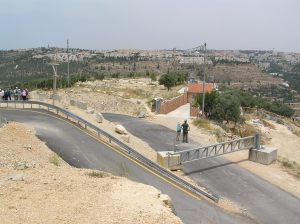
The wall, when completed will separate these two roads and an electric fence will surround the house, seen in this picture.
The family formerly farmed the land around the hillside here but the land was confiscated by the State although it had been in the family for several generations.
From the rebuilt house at Battir we walked to Battir village to have lunch. We walked across the countryside – 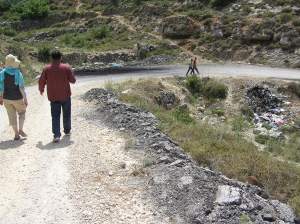 the terraces belonging to the family. We reached a road which was an important route into Jerusalem. However the IDF removed the surface of the road (you can see it piled at the side here) in order to prevent Palestinians using it.
the terraces belonging to the family. We reached a road which was an important route into Jerusalem. However the IDF removed the surface of the road (you can see it piled at the side here) in order to prevent Palestinians using it.
Later in the afternoon we went to the monastery at Cremisan to take part in their Communion Service in the OLive Grove. The service is particularly poignant as the separation wall is due to be built cutting the monastery off from its grounds. This means the beautiful trees that we were sat under being uprooted. There have been many protests and a court case but to no avail.
After the communion we went to meet representatives from the group Combatants for Peace. This group consists of Israelis and Palestinians who are former members of the armed forces who work together for a peaceful resolution to the conflict. We met with two former members of the IDF and one former member of Palestinian forces.
They told us that Combatants for Peace began 8 years ago during the 2nd intifada. At first those who met were very suspicious of each other but formed trust through dialogue. 5 groups now exist meeting regularly. Through dialogue they try to affect what is happening on the ground, and take part in demonstrations. Soldiers tend to be respected by their own people on both sides, and so their message has more chance of being respected also. They try to show that violence only leads to more violence and to promote dialogue instead of bloodshed.
They believe that the Israeli occupation is wrong and is an obstacle to peace. The Israeli population in general are blind to what is happening in the West Bank. So they try to take their message to Israeli and Palestinian populations through talks, tours and talks in schools.
The group has 500 members and thousands of supporters and all decisions are taken jointly.
“The cycle of violence has no meaning”
From there we traveled back to Beit Sahour to the Peace Park, where we had dinner.

